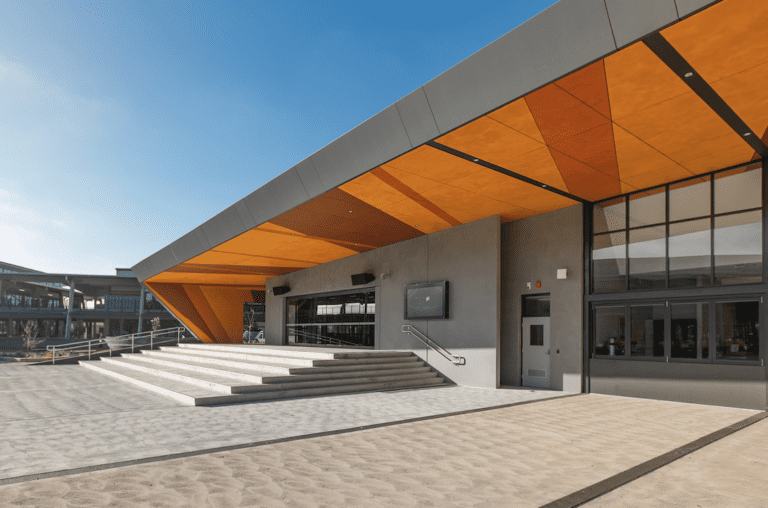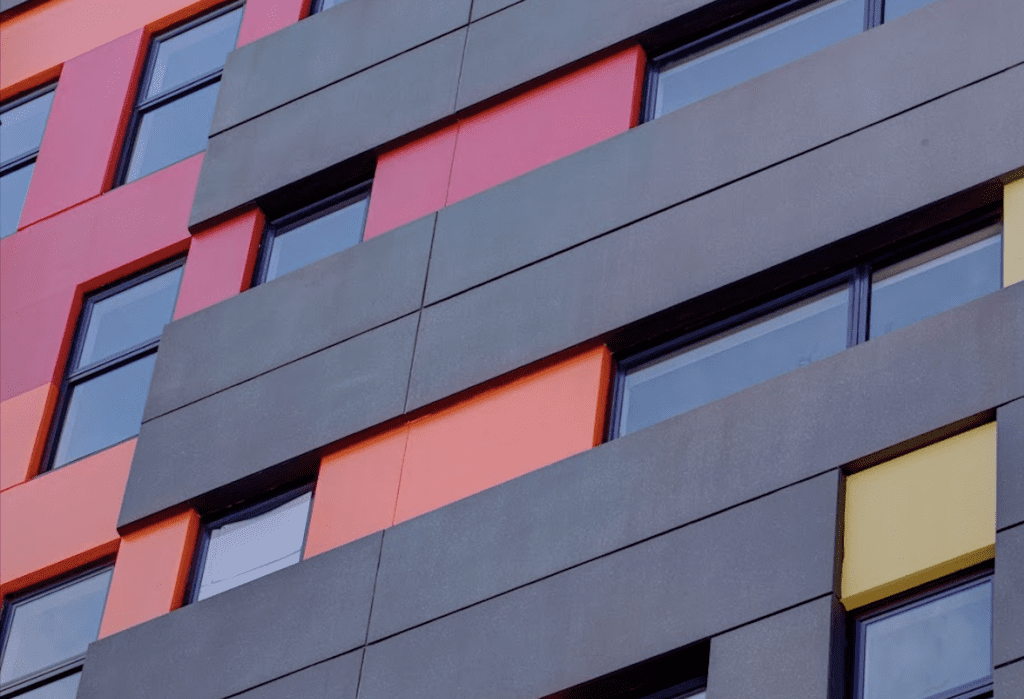Across urban landscapes and particularly in arid and tropical climates, colored concrete is constantly in use. Many great-looking façades and structures across different commercial spaces may not initially appear like the cold, gray concrete you may be used to. But, it is concrete!
It’s a testament to architects, designers, and technicians alike that concrete has so many uses most people don’t even consider. There’s a good reason it’s one of the most used building materials in the world. So how do we use it to transform our buildings or renovation projects?
We’re going to be breaking down everything you need to know about colored concrete, from integral concrete color to mineral stains and much more. Hopefully, you’ll find something here that will help you beautify your space with concrete!
Where Can I Use Colored Concrete?
Colored concrete can be used for a variety of building projects. Many residential and commercial structures can benefit from a splash of color, such as:
- Patios
- Staircases
- Pathways
- Driveways
- Kitchen Floors
- Basements
- Garages
- And Others!
We also know that concrete finds use in indoor as well as outdoor projects. Plus, the wide range of colors, textures and patterns that can be created with concrete offers almost unlimited possibilities for your design. And that’s at a much lower cost than other building materials like tile or wood.
To decide which style of concrete coloring is the best fit for your project, it’s important to know the benefits and limitations of each coloring method before getting started.
These days, there are two options out there: integral concrete color and concrete stain. Let’s cover both to give you a better idea of what’s best for your project!
Working with Integral Concrete Color
Integral concrete color (also known as integral color) is made by premixing various iron oxide pigments with grey or white concrete to achieve color. The now-colored concrete is then poured and cured. Sounds simple, right?
Unfortunately, finding the exact hue you desire using integral color can be difficult. The color spectrum you can pick from is small (mainly yellows, oranges, reds, and some greens and blues), and the dosage rates to achieve the color you’d like are very precise.
However, if you find a color that suits you, integral color will give you a long-lasting finished product that’s extremely low maintenance. Because the color is throughout the concrete, chips and scratches do not typically discolor the project—keeping its color consistent through years of wear and tear.
Why Integral Color Might Not Be Right for You
Integral color offers several benefits for high-traffic surfaces—so this coloring method excels in driveway and pathway applications. However, integral color has several limitations in exchange for its relative durability, so this method of coloring may not be for every project.
For example, only new concrete projects can take advantage of the coloring style. Furthermore, integral color cannot be used on cement-based overlays, making it less flexible than concrete staining.
Integral color also limits the options available for your design because the colors are limited. Since the color is premixed, an integral concrete color project often involves a clean-out fee for the mixer on top of your pouring costs.
Inconsistent concrete curing will affect color consistency and can require the concrete to be ripped up and poured again if it does not set properly.
While the longevity of this coloring process is admirable, the colored pigments only bind with the cement, not the aggregate. Because of this, chips may show sand and gravel within the concrete that remains uncolored. A large chunk removed from the surface will expose the aggregate and show discoloration in your design.
These chips are incredibly costly to fix, and it isn’t easy to find matching colors once your initial project has been completed.
The Basics of Colored Concrete with Concrete Stain
In contrast to integral color, concrete stains are applied after the concrete is poured. That means that there are a lot of benefits to this style of coloring.
The color is applied using a water-based stain that chemically bonds with the concrete pores—covering the concrete with a robust layer of color that protects and strengthens. Stain also penetrates deep into concrete, making it fade resistant, very hard for the color to chip, and impossible for it to peel.
If chipping does occur, patching is a straightforward process. New stain is applied, and the colors are matched easily. As a result, concrete stains offer custom colors, long-lasting aesthetic benefits, and increased durability to the stained concrete.
Concrete stains also offer significantly more artistic flexibility, allowing for much more individuality in your project. Stains can be applied to existing concrete and cement-based overlays and come in a wide array of crisper and more vibrant colors than the integral concrete.
And, because these colors can be mixed to create custom hues, the choices are virtually endless. Multiple colors can be added to the same slab of concrete, offering unlimited design possibilities!
At $3 per square foot on average, concrete stains, with their quality and versatility, are an ideal choice for new construction projects and renovations alike.

Nawkaw’s Colored Concrete Products – Stains for Any Situation
Each project has different requirements, so the Nawkaw range of products ensures you can deliver on your artistic vision. All Nawkaw products are water-based, non-hazardous, non-flammable, and have very low-to-zero volatile organic compounds, making them a safe and environmentally friendly option.
Mineral and acrylic stains provide different benefits depending on the project. One may be better than the other for your use! NawTone and NawTone-K, our flagship acrylic and mineral stain products, respectively, reflect the need for various options.
If you need water repellency, NawTone+Plus builds upon the original NawTone and helps protect your projects from water ingress! And if you need a glossy shine to your concrete, NawTone-G is perfect for creating a unique shimmer.
If choosing a mineral stain, NawTone-K Opaque gives you excellent coverage without chipping or peeling. And NawTone-K Metallic will leave your building shining like metal.
Final Thoughts
Ultimately, color solutions for concrete have excellent durability and can help you save money on your next project. Though there are several ways to color concrete, mineral stains often provide the most versatility and produce aesthetically pleasing results thanks to their range of high-quality staining products.
Nawkaw gives you all the tools you need to revitalize and strengthen your existing concrete structures and build your next creative vision. The massive range of color charts, color choices, and protection from lousy weather, wear, and tear makes acrylic or mineral stain from Nawkaw the perfect choice for most uses.
You can express your individuality as you construct, renovate, restore and preserve your home or community!
No matter which path you choose, don’t let something as simple as color keep you from making your dreams concrete.

